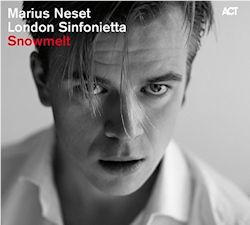Marius Neset is a Norwegian saxophonist. He is also an imaginative composer fusing many styles into attractive arresting cross-over work. Apart from the
opening Prologue, the movements of Snowmelt did not evoke, for me, much that was frosty or chill. For the most part, I preferred just to
sit back and listen to Neset’s imaginative constructions without considering any programmatic associations.
At the centre of the Snowmelt construct is Neset’s quartet of saxophone, piano, bass and drums, always smoothly integrated as soloists or group
into the total music fabric. Rhythm is the driver. As Neset comments, “This is rhythmic music and I needed the rhythm section from my own band to keep the
whole thing together.”
Neset clearly has catholic tastes in music and a remarkable span of knowledge. Claims are made that parts of Snowmelt were influenced by Mahler
(the Adagio of his Tenth Symphony), Stravinsky and Berg’s Lulu - an opera that deeply affected Neset.
The music is vital and energetic, smoothly lyrical, and very imaginative and involving. The Prologue opens disconcertingly with a prolonged
saxophone wail and tremor that suggests a wintry landscape still and chill before a note of blues is introduced. I will mention one or two movements to
give an idea of what the work encompasses. The first of the seven 'arches of nature', Sirens is scored first for intertwining woodwinds above a
rhythmic bass line the whole progressing into jazz improvisation with discords. Circles has a quasi-military/circus clowning flavour opposed by
sentimental strings and quivering woods. Caves has rhythmic and stylistic eccentricities, and, again, there is a feeling of colourful
extemporisation. Paradise has important material for piano and saxophone in blues. The piano’s material in the opening pages of this lovely
movement is most attractive and almost impressionistic, the underpinning is for bass and drums with brushed cymbals. Pyramiden is joyous and
jubilant. I was very impressed with the romanticism of The Storm is Over movement. A welcome stillness at the beginning before a sighing saxophone
and lower strings proclaims a peace. Here is a welcome touch of warmth and romance, the music proceeding to popular jazz for close dancing; delectable.
Ian Lace
A very attractive and imaginative cross-over classical/jazz programme.
